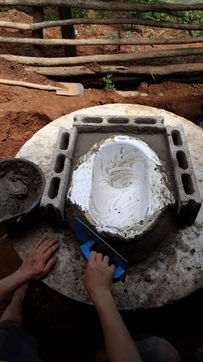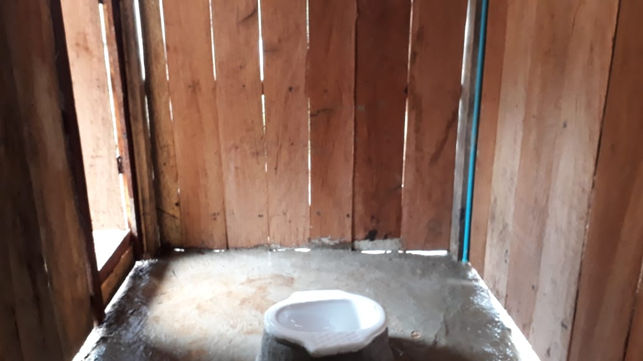Toilets
Prior to this project there were no toilets in the village except for two beside a new school built in 2019. Bounchan made a proposal in December 2019 to construct 37 toilets at a cost of approximately $6,450 USD ($175 USD each). The project was begun with a proof-of-concept installation in July 2021. Check out Bounchan's project proposal here. Progress is described here with the most recent news at the top.
New skills, wommen's work,
inequality September, 2022
(FB September 9, 2022)
I’m always excited receiving photos from Laos. What particularly caught my attention in the 1st photo of this posting, apart from it being a lovely photo, was the appearance of the blue PVC water pipes. (Of course, it also says much about women’s roles in the village.)
The new dam and water pipeline built in April 2021 has provided enough water capacity that some enterprising families are building large toilet huts with room for a tap and a shower. Resourceful villagers are now skilled at creating networks of blue water distribution pipes – photos 2, 3, 4, and 5.
Since village women have been responsible for bringing water from the pipeline terminal tap to the house for family use, their animals, and the family vegetable plot, a nearby tap reduces their workload. An enclosed shower beside the family house offers more privacy than at the pipeline terminal tap as is clear from photo 6 – taken after the pipeline was inaugurated in April 2021.
In addition to domestic duties, women have to gather firewood in the jungle – photo 7, plant & tend the rice fields – photo 8 & 9, and perform much other hard work. (Photos 8 & 9 taken May & October 2018.)
You may have noticed that the toilets project has been taking a long time to complete. In part this was due to severe Covid restrictions from about the beginning of December 2021 through the end of April 2022 – photos 10 & 11. However, unlike the solar generator and water pipeline projects, the toilets require a significant buy-in from each family: digging holes about 2m (~6.6 ft) deep and 1.2m (4 ft) wide, and a trench about 3 m (10 ft) long for the waste water cleanout; cementing the toilet bowl to the septic tank cover; building a privacy hut around the toilet.
Much to our project coordinator Bounchan’s dismay, one-third (13) of the 39 village families have been hesitant to build their toilets, no doubt due to unfamiliarity with them as well as ordinary resistance to change. It took pressure from village chiefs & Bounchan to get them grudgingly onside – and the results sometimes show this lack of commitment.
But there is a pattern, most of the hesitant families are the same ones who don’t see value in sending their kids to the village school, and don’t plant enough rice or care properly for their fields and animals, and suffer nutritionally & economically as a consequence. When their rice supplies run out they are forced to work for other families weeding rice fields and doing odd jobs. With no surplus rice or animals to sell to itinerate middlemen, they remain economically disadvantaged, which has led to inequality and some jealousies in the village.
Photos 12 & 13 show two villagers happy with their new toilets.
Toilets update August, 2022
(FB August 30)
Work continued on the toilet project over the summer during the rainy season. To date 26 toilets have been completed, three are 50% complete, and 10 are 40% completed -- according to Bounchan’s assessment. All septic tanks and covers have been installed.
Whereas the April, 2022 post presented photos of the septic tank excavations and installations, this post focuses mainly on the finishing work of installing toilet bowls and construction of small privacy huts around the toilets. But, I couldn’t resist the 1st photo with all the villagers & kids enjoying installation of septic tanks, and the 2nd photo with one very happy villager. In the final three photos zinc roofs are being installed.
(In some of the earlier project photos you may have noticed thatched roofs. These, unfortunately, must be replaced after about 5 years as they are not entirely waterproof and may harbour unwanted insects and animals. Affluent villagers have been replacing thatched roofs with corrugated zinc sheets.)
April 2022 (FB April 14, 2022)
Village attention during February & March 2022 was focused on preparing the upland rice fields for the rainy season that begins in May. (Upland rice is not grown in flat, flooded paddies, but planted as seeds on hillsides so rain is critical.)
The photos show typical construction of two of the toilets and the group effort involved. I particularly enjoyed the 1st photo with mother and baby watching dad digging, the 5th photo with the young man in red beaming and flashing a victory sign, and the 14th photo of a homeowner standing on a toilet cover with the hint of a satisfied smile. Backgrounds in the 2nd, 5th and 9th photos give glimpses of village houses. (Let us hope that the apparently below-grade level of the toilet cover in the last photo does not present a problem with water run-off during the rainy season.
On the move (FB Feb 23, 2022)
After completion of a proof-of-concept toilet in summer 2021 the project was very pleased to receive a $10,000 CAD grant from an old electrical engineering classmate of mine, Lorne T. Alas, Covid intervened and Laos, which was previously pretty much unscathed until a blip in April/May 2021, was forced into a severe lockdown which only eased in January 2022 and caused additional economic hardship on top of the existing collapse of the tourist industry.
Finally, on February 23rd the 1st shipment of concrete toilet components headed to Phoumieng after crossing the Mekong by ferry. The shipment had to be transferred to the three Chinese buffalo tractors shown in the video for the final 8 km ride to the village.
CAUTION This video sometimes has a "mind of its own". On an Apple iPhone it might start automatically and loop when it shouldn't. Keep tapping on it until it pauses, or scroll up or down.

Proof of concept (Summer 2021)
Delivery & excavation. The 1st two photos show sections of the septic tank being unloaded from a “Chinese buffalo tractor”. Photos 3 & 4 show kids getting into digging holes for the septic tanks – what kid could resist the opportunity! Bounchan appears in the deeper hole in photos 4 & 5. Bounchan’s mother, Daw, is helping out in photo 6, there’s not much she doesn’t do. The final two photos show the kids getting into the work.
Assembling a toilet. Two septic tanks are used in each toilet and constructed from two stacked pre-cast concrete cylinders for each tank. As the cylinders are positioned in the pit in photos 4 & 5 there is quite an audience looking on since this is the village’s first toilet. Zoom in to check out some of the faces, a couple of the guys in photo 4 have fashionable side cut haircuts. Bounchan is applying cement to the top of the lower cylinder in photo 6 which will glue the lower and upper cylinders together. A layer of cement on the top of the upper cylinder will glue the cover that’s being rolled to the site in photo 8. Photos 11, 12, and 13 show the squat bowl being cemented in place. The thin blue pipe in the last photo is likely a vent to prevent the build up of gases.
First toilet completed. Here are two photos of the first completed toilet. Bounchan is waiting for rainy season to taper off to allow transportation of materials for another four.


























































